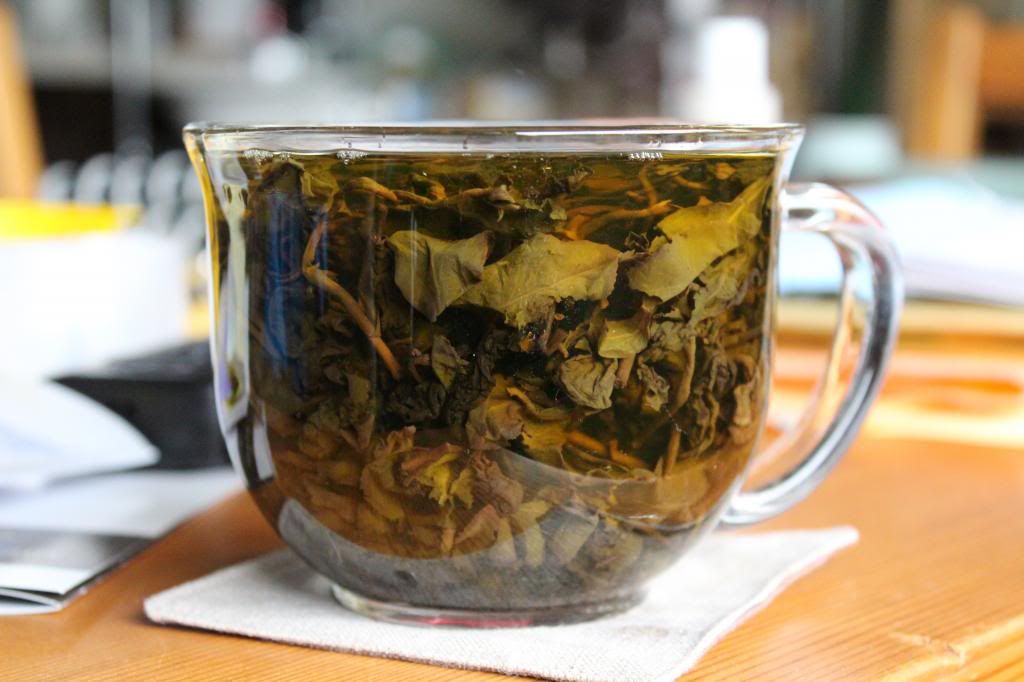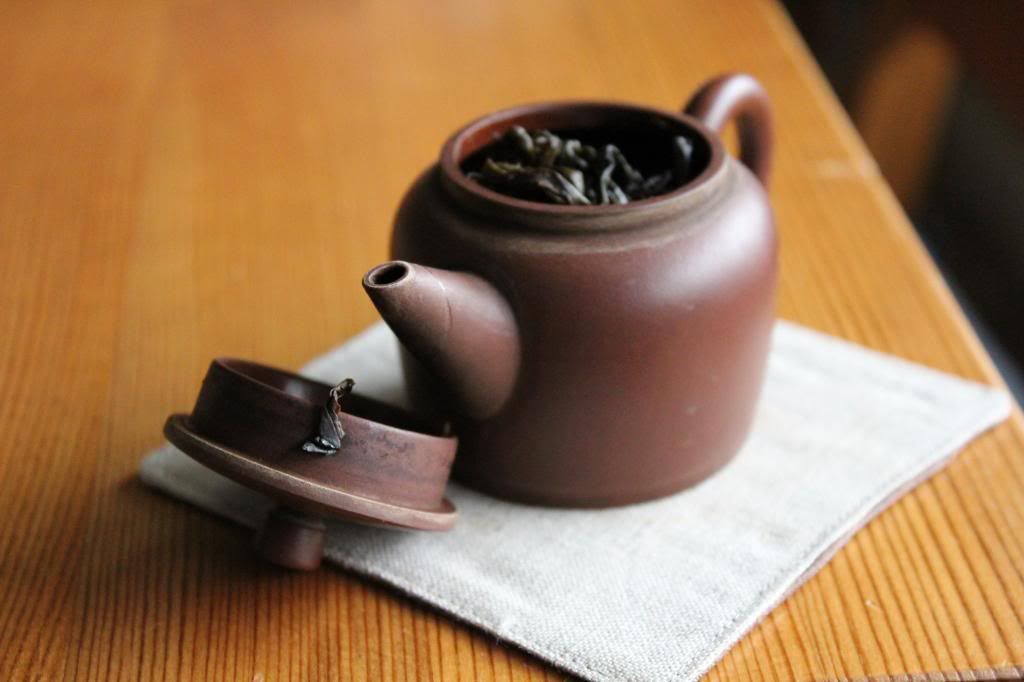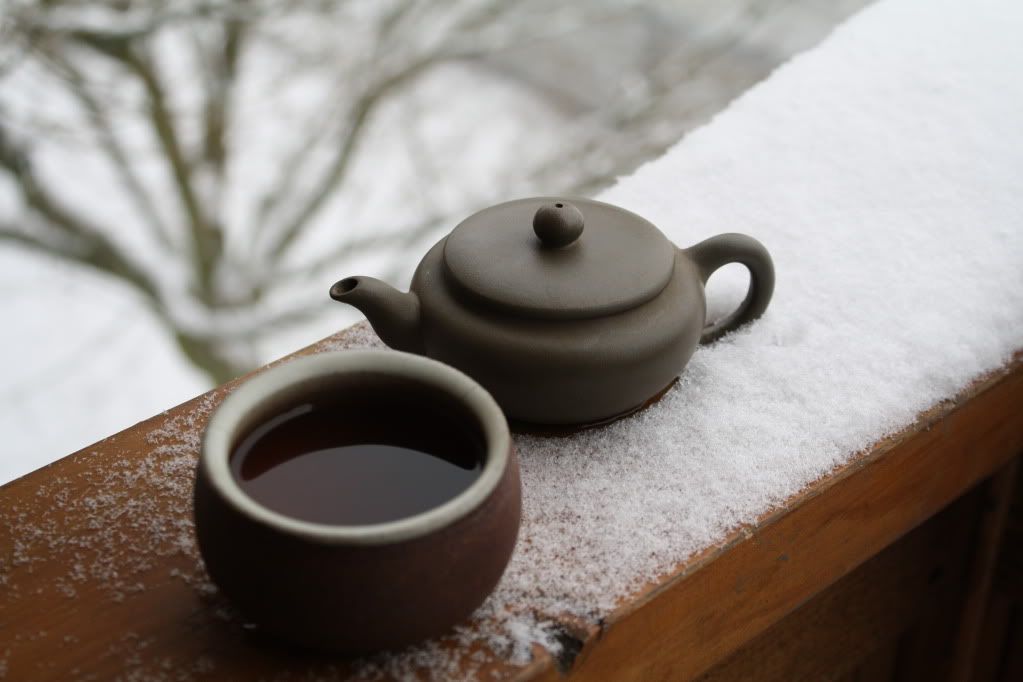I recently started drinking two charcoal-roasted dong ding oolongs I've been storing since mid 2010, both purchased from Shiuwen at
Floating Leaves Tea. Though I tried both teas a few times during the last three years, the most recent experience was definitely the most interesting, leaving me with a few thoughts on aging oolong, and tea in general.
The first tea is a heavily-roasted dong ding. At the time of purchase, I enjoyed the tea but thought it would probably become more balanced (the roast would diminish, that is) if it were aged for a relatively short period, so I completely filled an airtight ceramic container with about 250g (my whole stash of a tea that was already unavailable [Shiuwen couldn't remember which farmer she bought it from!]). In the intervening tastings, the tea tasted roughly the same as I remembered, and it wasn't until pulling it out a couple months ago I really thought it tasted like all of the flavors were really blending well. The vibrant tea base, which was always there and present in later brewings, showed itself early on, and the brewing ability appeared to still be strong.
The second tea is what I would consider medium-roast, though compared to most dong ding I find it's actually pretty high (good charcoal roasted dong ding seems to be getting harder and harder to find). The tea was eminently drinkable back in 2010 and, having a larger quantity in my possession I kept a similar amount (~250g in an identical container). Though I didn't feel like the tea had any flaws or "too much" of any characteristic, I wanted to be able to drink it longer and was curious to find out if it would change remarkably or improve in some way with a handful of years. Each time I tasted the tea, I was instantaneously transported to the week I spent in my parents' basement in early July 2010, hammering out the last few overdubs for my
first album, riding a creative high and thinking very positive thoughts about making my first confident artistic statements and about the potential my somewhat strange music might have to connect with people as it made its way into the world. After three years of artistic advancement, but also increasing disillusionment and resignation to a more pragmatic outlook, the ability to magically return to that naïve optimism has been a welcome feeling.
On the most recent re-visit, though, I found the tea was tasting a bit tired--that surge of strength on the second or third infusion wasn't quite as forthcoming as it had been before. The roast had diminished a little, which is ok with me (it's aging, after all), but there certainly wasn't any "aged oolong" flavor coming through, like there was in aged teas I'd purchased. Three years isn't very long, if you're expecting a full-on aged oolong, but if your tea's getting stale, you're likely entering territory that will require either re-roasting or very long-term aging to produce a tasty tea.
So, after these two fateful encounters, I resolved to continue to sparingly drink the first oolong until it's gone, and to consume the second as soon as possible. The experience has left me with some opinions that are by no means ironclad, but are--unlike quite a bit of tea wisdom that gets re-re-repeated without much evidence--based on the personal experiences of one tea drinker who's been doing it for a few years. If you're thinking about aging oolong (or other teas), I invite you to join in learning from my experience, and consider this advice.
Buy quantity. 250g may seem like a lot when you're buying for immediate consumption, but once you taste it once a year or more for a few years, you'll suddenly be down to a much less significant quantity. At this time, you'll start dealing with
container issues--oolong should be in an airtight container, and once you remove tea from a previously-full container and reseal it, you're storing your tea with a quantity of air that's not going to do it any favors. This is a difficult issue to confront if you want to periodically taste your tea. Will you buy smaller and smaller containers and move the tea as the quantity dwindles? Will you store in multiple containers and designate one as the "trying" container (risky, because tea ages better the larger the quantity that's stored together)? In our minds we tend to build up the potential of a tea that's been aging--if you unseal 200g of tea after 20 years of aging, you're still only left with roughly 25 sessions worth of tea (by my brewing parameters). That'll go pretty quickly, no matter how big a quantity you told yourself 200g was when you first started aging the tea!
The tea will change. This seems like a no-brainer, but it's just about the most important thing you need to think of when investing in a tea (of any kind) to age. Ask yourself: "Do I love this tea just the way it is right now?" If not, "Do I think the things I don't like about this tea will get better if I age it?" Or at least, "Will I be ok if the tea transforms into something almost completely different from what it is right now?" If you've tried aged Wuyi yan cha or Taiwanese oolongs, you probably know they don't really taste anything like fresh examples. In the case of the second tea, when I found it losing steam and tasting like a hollower version of its original self, I realized I wasn't hoping for that tea to transform at all--I mainly just wanted to experience the original tea as long as I could. As difficult as it was to give up the physical sensory link to my memories from 2010 (talk about a life lesson in general!) and move on, I decided it would be better to go to that place again a few more times while I could and still have the tea taste roughly the same. In the case of the first tea, I knew I wanted the roast to mellow a bit, and fortunately it did. After experiencing what happened to the second tea, I realized the first tea is now at the ideal quality peak I originally sought after--since it's exactly how
I wanted it to be, I am risking another disappointment if I keep aging it! The very act of squirreling tea away for decades of hypothetical improvement is sort of stingy in the first place, so it can be difficult to unclench the fist and say, "Ok; it's time to stop holding back and just drink it," and to do so
within a reasonable time period, while the tea is in its current form! Remember that the purpose you bought the tea in the first place was enjoyment; if it's already at a peak of enjoyability in comparison with other teas you've tried, what are you doing setting it aside to change?! Live a little bit--the tea's quantity certainly isn't going to increase as it ages! This leads to the final main point.
Anything can happen to the tea. Whether it's good or not-so-good, when you stash tea away, there's a chance that
anything can happen to it. Though pu-erh aging takes top prize for most potential aging catastrophes, oolong has just as much potential to go brutally stale, get humidity damage, or just plain transform into a tea that has none of the original's strengths and few (if any) benefits of aging. You're rolling the dice when you age a tea, and if you're happy with a tea the way it is right now, you need to take the risks into consideration before you make the leap. Conversely, it's generally not good practice to age a tea you think is shitty and hope that it'll become amazing. However, you'll certainly avoid the chance that a tea you love will lose its best qualities! Who knows--if I had kept the second tea for 20 more years, maybe the staleness would have moved into a real aged character, but in this case I wasn't willing to give up the experience of the original tea for that chance.
I still have some quite large quantities of yan cha in storage. Some are wax-sealed and some are simply closed in containers. I was never as emotionally invested in these teas, but this recent experience has caused me to consider my original impulses. I enjoy aged yan cha and have tried a few pretty recent examples that exhibit the sort of mellowed, medicinal flavor that comes with aging, and I also love roasty, punchy young yan cha, so either direction the tea could go would be ok with me. Then again,
anything can happen, so I need to be prepared for stale tea. Luckily, I've got enough that I don't mind seeing what happens to one or two jars after a decade or more. Time will tell...
Anybody out there have any long-term oolong aging stories to share?
On an unrelated note, I have a couple of
Yixing for sale...music remains a labor of love with few material benefits.
















